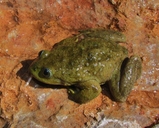|
Distribution and Habitat
Country distribution from AmphibiaWeb's database: Argentina, Bolivia, Chile, Peru
Known from the Lake Titicaca region of Peru and Bolivia, and the Cuzco region of Peru. Due to unclear taxonomy, it may also be distributed in Andean highlands of Bolivia and into extreme northeastern Chile and Jujuy Province, Argentina but it is controversial.Comments
Etymology: Telma (from Greek) A pond or pool and marmor (from Greek) marble; sparkle or glisten.
This species was featured in News of the Week 27 March 2017:
High elevation tropical environments are experiencing rapid change as a consequence of climate warming, and their glaciers are melting fast. The ongoing deglaciation is opening up new aquatic habitats for pond-breeding amphibians. Seimon et al. (2017) describe the vertical migration of Pleurodema marmoratum, Rhinella spinulosa and Telmatobius marmoratus to newly deglaciated ponds up to 5400 m in the Andean Cordillera de Vilcanota of Peru. Over the past decade, the newly established anuran populations have endured chytrid epizootics, changes in pond hydrology, and sharp reduction in the abundance of T. marmoratus. Despite these challenges, the three species continue to breed in this system of connected wetlands, and populations of T. marmoratus have recently recovered, possibly because individuals have acquired greater resistance to chytridiomycosis. (Alessandro Catenazzi)
This species was featured in News of the Week 1 July 2024:
High in the mountains and the Altiplano in the Andes in South America, live the Andean water frogs of the genus Telmatobius, a group characterized by their mainly aquatic habits at predominantly high elevations. Where and when the specious water frogs evolved and acquired their adaptations to aquatic lifestyle was unknown until recently, when a new fossil species of Telmatobius was described: Telmatobius achachila. The new species, described by Gómez and collaborators in 2024, comes from the Bolivian Altiplano and is estimated to have lived 12 Ma (million years ago) in the Miocene. The fossil is a disarticulated skeleton of a male of approximately 80 to 90 mm in length. The anatomical characteristics of the skull, the vertebral column, and the limbs allowed Gómez and his team to recognize this fossil frog as a new species and establish its relationship to other Telmatobius species. They found that it is nested within other living species (its close sister species is Telmatobius marmoratus), and it is not the most ancestral one. The specific characteristics of the lower jaw and hyoid show that aquatic feeding behavior (inertial suction feeding) was already typical in this group of frogs by the Miocene. The finding of Telmatobius achachila, along with additional information from its discovery site, show that by the Miocene the Bolivian Altiplano was a humid low to mid elevation forest and Telmatobius had already acquired the diagnostic characteristics of the genus. (Maria C. Vallejo-Pareja)
Originally submitted by: Emma Steigerwald (2021-08-20)
Edited by: Michelle S. Koo (2024-07-01)Species Account Citation: AmphibiaWeb 2024 Telmatobius marmoratus: Marbled Water Frog <https://amphibiaweb.org/species/2708> University of California, Berkeley, CA, USA. Accessed Jan 19, 2025.
Feedback or comments about this page.
Citation: AmphibiaWeb. 2025. <https://amphibiaweb.org> University of California, Berkeley, CA, USA. Accessed 19 Jan 2025.
AmphibiaWeb's policy on data use.
|
